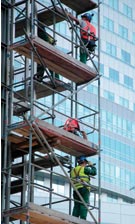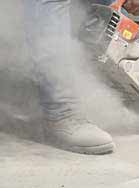We live in a world of labels. We trust some labels to be precise: We expect a 250 mg capsule to deliver 250 milligrams of medication, and our 2-liter soft drink bottle undoubtedly holds two liters. But we also accept that some labels provide us only with an estimate.

WORK and safety footwear is developed for a specific end user, whether that person is an electrician or a drywaller. Choosing the proper safety and work boot can be as easy as breaking down what is most important to keep safe and comfortable on the job. Here are a few things to consider.
In any work environment, there can be many reasons to keep sound levels within a reasonable range. Sound levels above this range are perceived as "noise." Noise can distract the workforce, creating an unsafe workplace. Or, worse yet, it can cause hearing loss.
IGNORANCE is never bliss when it comes to the safety clothing you should be wearing. In fact, ignorance is no longer an excuse accepted by employers for workers not wearing the proper gear. Organizations such as OSHA impose a variety of safety requirements, and some insurance companies compel certain shops to publish minimum safety requirements in full view of the workers.
No new bronchiolitis obliterans cases since 2003 among microwave popcorn manufacturing workers have come to its attention, OSHA said in its notice announcing the meeting.
The event will focus on best practices for effective hearing protection programs.

Apparel, ergonomic furniture, security, and fire protection were hot at this year's event. The next A+A will take place Nov. 3-6, 2009.
The "supersport" motorcycles are extremely popular, with registrations up 83 percent in 2005 from 2000. Their drivers have a worrisome death rate.
The U.S. Labor Department, U.S. Chamber of Commerce, National Chicken Council, and American Meat Institute filed amicus briefs in the appeal.
This will be the latest hearing on Capitol Hill to ask why some responders and recovery workers developed respiratory illnesses.
The second annual event is intended to help employers of about 4,000 laborers who move from Arizona to California to harvest crops.
Safety committee chairmen in both houses of Congress want answers from MSHA about the Crandall Canyon mine disaster Aug. 6, which claimed nine lives in all. MSHA has already appointed its own investigative team.

A disgruntled field employee (in front of a crew of scowling, arms-crossed guys) tossed a set of dirty, beat-up safety glasses at me in disgust. "They're scratched, this no good piece of #@*!" he exclaimed. The explanation: A piece of debris or gravel had been slung while on a maintenance job, deeply scratching the lens.
File a notice by Oct. 1 if you want to testify at the hearing, where opponents will challenge the plan to recognize "good design standards."
The investigation was opened at the request of Tillotson Corp., d/b/a Best Manufacturing, which is being acquired by Showa, a Japanese glove maker.

AS the November 2008 deadline approaches for compliance with the Federal Highway Administration's new high-visibility mandate, it is critical that individuals in affected industries know how they will be affected by the changes to come. Affected occupations include road workers and first responders exposed to the low-visibility hazards of moving vehicular traffic.

YOU buy and use fall protection harnesses, lanyards, rope grabs, lifelines, retractables, and other equipment every day. Each item is labeled, ensuring that it conforms to ANSI specifications and OSHA regulations. These product certifications give you confidence and peace of mind.

I read the preceding statement while performing a simulated OSHA inspection. Most fall-related injuries result from the lack of fall protection. Additional injuries occur from improper use of fall protection—utilizing a body belt instead of a full body harness, improper use of lanyards, or utilizing an inadequate anchorage point.

You may not realize that a worker's shoes make him or her more productive, but Tom Votel makes a good case below for the proposition. And if good footwear and inserts can boost productivity, it stands to reason that poor footwear can harm it. Votel, President and CEO of Ergodyne discussed footwear's role in worker productivity during an April 13, 2007, conversation with Occupational Health & Safety's editor. Excerpts from the conversation follow.
Without wearing the necessary protective equipment, more injuries and fatalities will occur on the job. This is something Jerry Bach, vice president of Sacramento, Calif.-based Safety Center, Inc., will not tolerate. Wearing personal protective equipment is not only common sense that will keep you alive and safe, it also cuts down on worker's compensation claims, insurance premiums, and personal injury lawsuits for which employers must pay the price.